Devotee: Can you explain how the principle of disciplic succession works? I was under the impression that in your teaching there must be an unbroken chain of disciplic succession beginning with God Himself, in order for the knowledge to be properly understood. But when I read Bhaktivedānta Swāmī Prabhupād’s Bhagavad-gītā As It Is, I found that the disciplic succession contained only thirty-eight names, although it says that the system is fifty centuries old. Is this a complete list, or are some names left out? How are we to understand these apparent historical discrepancies?
Śrīla Śrīdhar Mahārāj: Our Guru-paramparā, disciplic succession, follows the ideal, not the body; it is a succes sion of instructing Spiritual Masters, not formal initiating Spiritual Masters. In a song about our Guru-paramparā written by Śrīla Bhakti Siddhānta Saraswatī, it is mentioned:
mahāprabhu śrī chaitanya rādhā-kṛṣṇa nahe anya
rūpānuga janera jīvana
The highest truth of Kṛṣṇa consciousness comes down through the channel of Śikṣā-gurus, instructing Spiritual Masters. Those who have the standard of realisation in the proper line have been accepted in the list of our disciplic succession. It is not a Dīkṣā-guru-paramparā, a succession of formal initiating gurus.
Dīkṣā, or initiation, is more or less a formal thing; the substantial thing is śikṣā, or spiritual instruction. And if our Śikṣā-and Dīkṣā-gurus, or instructing and initiating Spiritual Masters, are congruent, then we are most fortunate. There are different gradations of Spiritual Masters. In the scriptures, the symptoms of the Guru and the symptoms of the disciple have been described; the Guru must be qualified in so many ways, and the disciple must also be qualified. Then when they come in connection, the desired result will be produced.
We are concerned with Kṛṣṇa consciousness, wherever it is available. In the Bhagavad-gītā and especially in the Śrīmad Bhāgavatam, Kṛṣṇa says, “I start the Kṛṣṇa consciousness movement, but gradually by the enervating influence of the material world, it weakens. When I find that it has diminished considerably, I return and begin a fresh movement. Again, when I find that it is becoming degraded by the adverse influence of the environment, I send one of My representatives to clear the path and give some fresh energy, invest some fresh capital in My Kṛṣṇa consciousness movement.”
What is Kṛṣṇa consciousness? We must examine the standard of knowledge. The Guru should try to impart to his disciple the capacity of reading what Kṛṣṇa consciousness really is. Kṛṣṇa consciousness is not a trade; it is not anyone’s monopoly. The sincere souls must thank their lucky stars that they can appreciate what Kṛṣṇa consciousness is, wherever it may be.
Devotee: How are we to understand that in the history of our disciplic succession, it appears that there are gaps where there was no initiating Guru present to formally accept disciples?
Spiritual light years
Śrīla Śrīdhar Mahārāj: We are not concerned with a material connection. The mediator is not this flesh and body as we generally think. In studying the development of scientific thought, we may connect Newton to Einstein, leaving aside many unimportant scientists. We may trace the development of science from Galileo to Newton, and then to Einstein, neglecting the middle points. If their contributions are taken into account, then the whole thing is taken into account, and lesser scientists may be omitted. When a long distance is to be surveyed, the nearest posts may be neglected. Between one planet and another, the unit of measurement is the light year; distance is calculated in light years and not from mile to mile, or metre to metre. In the disciplic succession, only the great stalwarts in our line are considered important.
Devotee: There was one question still in my mind on Guru-paramparā which was not clarified. Between Baladev Vidyābhūṣaṇ and Jagannāth Dās Bābājī is a gap of almost a hundred years. How is it that between the two of them no one is listed in our Guru-paramparā?
Śrīla Śrīdhar Mahārāj: We have to forget material considerations when we consider the spiritual line. Here in this plane, the spiritual current is always being disturbed and interrupted by material obstructions. Whenever truth is interrupted by a material flow and becomes mixed or tampered with, Kṛṣṇa appears to again reinstate the truth in its former position of purity ( yadā yadā hi dharmasya glānirbhavati Bhārata). That attempt is always being made by the Lord and His devotees.
The flow of spiritual truth is a living thing, not a dead thing. The vigilant eye of the Lord is always over our heads, and whenever it is necessary to keep the current pure and flowing in full force, help descends from above. Kṛṣṇa says to Arjuna, “What I say to you today, I spoke to Vivasvān many, many years ago. Now, by the influence of material conception, that very truth has become contaminated, and so again I say the same thing to you today.”
Religious mutations
Here in the material world, the material consideration is always tampering with the spiritual current; the purity of the truth is always being disturbed. So, sometimes Kṛṣṇa has to come Himself, and sometimes He sends His personal representative to again reestablish the truth in its former and pure state.
When the truth is sufficiently covered, disturbed, and mutilated by the influence of māyā, the illusory energy, then an attempt is made by the devotees of the Lord, or by the Lord Himself, to rejuvenate it and return it to the previous standard of purity. We cannot expect truth to continue here in this world of misunderstanding without any tampering or interruption. It is not possible.
The intelligent will understand how to apply these principles practically. Suppose we are writing a history: we will note the main figures in the history, set aside those who are not so qualified, and begin the dynasty in order of their importance. Those who are negligible will not be mentioned. In a similar way, those who are really thirsty for spiritual truth like to see the line of pure spiritual her-itage. They search out where it is to be found, connect the dynasty of stalwart teachers together, and say, “This is our line.”
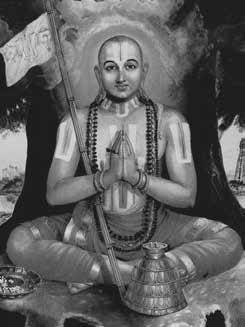
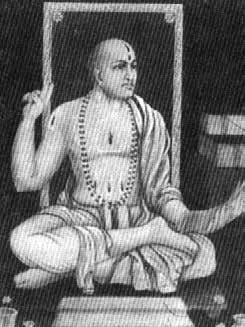
The disciplic succession is not a bodily succession. Sometimes it is present, and sometimes it is lost and only appears again after two or three generations, just as with Prahlād Mahārāj. He was a great devotee, but his son was a demon; then again his grandson was a devotee. Even in the physical line we see such interruptions. In the spiritual line we also see the channel of truth affected by the influence of māyā, or misconception. So, the experts will seek out the important personages in the line.
Copernicus, Galileo, Newton, and Einstein
Suppose a scientist researches some truth. After a few generations, another scientist comes and takes up that thread and continues his research. Then after a few more generations, another comes and takes up that thread and goes on. If we are to understand the real channel through which the particular research is progressing, we will have to study the important thinkers who helped bring it out.
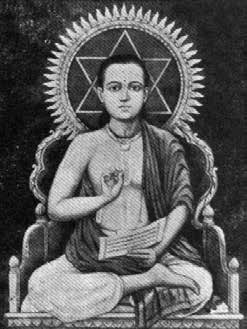
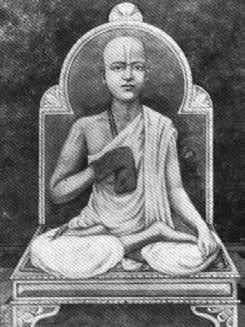
We see that Copernicus has contributed something before Galileo began, then Newton came. Then there may be a gap for some time, and from Newton, we find that Einstein took it up. In this way, there may be a gap, but still that thread is continued. An intelligent man will see that it began with a particular person, and then it came to another, and then came here. That will be the proper line of research. So, in the spiritual line this also holds true.
Those who cannot understand this simple point are guided by physical considerations. They do not understand what is real spiritual truth. For them, the physical continuation is the Guru-paramparā. But those who have their spiritual eyes awakened say, “No. What was there in the first Āchārya is not found in the second or the third. But again we find the same standard of purity in the fourth Āchārya.” The Gauḍīya sampradāya of Mahāprabhu is one, and whoever contributes to that real line will be accepted.
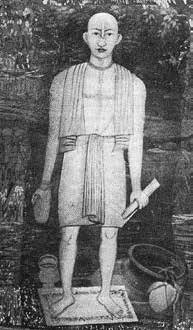
Śrīla Baladev Vidyā-bhūṣaṇ presented the Govinda-bhāṣya, commentary on Vedānta philosophy. His enlightened thought is a valuable contribution to our sampradāya.
Śrīla Baladev Vidyābhūṣaṇ’s contribution to the sampradāya is no less important than that of the other great stalwarts in the line. He may be a member of another line, the Madhva sampradāya, in the physical sense, but his contribution, especially in attracting people to Gauḍīya–Vaiṣṇavism with his commentary on the Vedānta-sūtra, cannot be neglected by the students of posterity. So, his contribution has been utilised by our Āchāryas, considering the degree, the essence, and the purity of his thought in our spiritual line.
Śāstra-guru, Śikṣā-guru, Dīkṣā-guru, and Nām-guru are all taken together; in this way a real channel has been given to save us, to keep up the flow of the highest truth from that world to this world. This policy has been adopted by the Āchāryas. Wherever we have found any contribution that is, by the will of Kṛṣṇa, the highest contribution to the line, we have accepted it. So, we accept Śāstra-guru, Śikṣā-guru, Dīkṣā-guru, Mantra-guru, Nām-guru—we accept them all as our Guru.
We give respect to Rāmānuja, who is the head of another school of Vaiṣṇavas, but we do not give respect to a sahajiyā, an imitationist who is in the line of Mahāprabhu only in the physical sense, but who is mutilating and tampering with the real teachings of Mahāprabhu. The imitationists are not considered. Although in a physical sense they are in the line of Mahāprabhu and Rūpa and Sanātan, when we go to judge the very spirit of the line, we see that they are nowhere. Their connection with Mahāprabhu is only a physical imitation.
On the other hand, we find that Rāmānuja has made a substantial contribution to Vaiṣṇavism, Madhva Āchārya has given a sufficient contribution to Vaiṣṇavism, and Nimbārka has also made his contribution, so we accept them, according to our necessity. But we reject the physical so-called current-keepers because what is found there is all mutilated and tampered with.
There is a proverb. “Which is more useful: the nose or the breath?” The intelligent will say that the breath is more essential than the nose. To sustain the life the nose may be cut off, but if the breath continues, one may live. We consider the breath to have more importance than the nose. The physical form will misguide people to go away from the truth and follow a different direction.
We don’t consider the body connection important in the Āchāryaship. It is a spiritual current, and not a body current. The disciple of a true devotee may even be a nondevotee. We admit that, because we see it, and the Lord Himself says in Bhagavad-gītā (4.2):
sa kāleneha mahatā
yogo naṣṭaḥ parantapa
“The current is damaged by the influence of this material world.” In the line, some are affected, go astray, and may even become nondevotees. So, the continuation through the physical succession is not a safe criterion to be accepted. We must trace only the current of spiritual knowledge.
Wherever we can get that, we must accept it, even if it comes from the Rāmānuja, Madhva, or Nimbārka sampradāya. As much as we get from them substantially, we accept, and we reject the so-called followers of our own tradition if they are mere imitationists. The son of a political leader may not be a political leader. A political leader may also have a political succession, and his own son, although brought up in a favourable environment, may be rejected. A doctor’s son may not be a doctor. In the disciplic order also, we admit the possibility that they may not all come up to the same standard. Those who do not should be rejected.
And if the truth is found in a substantial way some-where else, that should be accepted. Wherever there is devotion and the correct consideration about Śrī Chaitanya Mahāprabhu, our Guru is there. Who is our Guru? He is not to be found in the physical form; our Guru is to be traced wherever we find the embodiment of the pure thought and understanding which Śrī Kṛṣṇa Chaitanya Mahāprabhu imparted to save us.
Baladev Vidyābhūṣaṇ was very akin to the Madhva sampradāya. But when he came in connection with Viśvanāth Chakravartī Ṭhākur, he showed great interest in Gauḍīya–Vaiṣṇavism. He has also commented on the Śrīmad Bhāgavatam and Jīva Goswāmī’s Ṣaṭ-sandarbha. And that enlightened thought is a valuable contribution to our sampradāya. We cannot dismiss him. He is our Guru.
At the same time, if my own relatives do not give recognition to my Guru or to the service of Mahāprabhu, I must eliminate them. Śrīla Bhakti Siddhānta Saraswatī Prabhupād has explained the Śikṣā-guru-paramparā in this way. Wherever we find the extraordinary line of the flow of love of God, and support for the same, we must bow down. That line may appear in a zigzag way, but still, that is the line of my Gurudev. In this way it is accepted. We want the substance, not the form.
The zigzag line of truth
We have left all social concerns and so many other shack-les. For what? For the Absolute Truth. And wherever I shall find that, I must bow down my head. And if a great soul shows us, “This is the path to where you will find your thirst quenched. The line is in this zigzag way”, we must accept that for our own interest. We are worshippers not of form, but of substance. If the current of spiritual substance comes another way, but I think that I must try to go this way to reach my goal, it is only jealousy, blind tenacity, to stick to the physical thing. We must free ourselves from this material contamination and try to understand the value of spiritual truth. We should always be prepared for that. We must follow what is necessary, for our own interest.
I am not a servant of A, B, C, or D. I am a servant of Mahāprabhu. I may have to turn this way or that way, or whatever way will be favourable to reach my Lord. Wherever I feel the presence of my Lord in an intense form, I must be attracted to that side. We are out for that thing, and not for any fashion or formality; that will ham-per our cause.
Kṛṣṇa says, “Sarva-dharmān parityajya Mām ekaṁ śaraṇaṁ vraja.” Wherever we shall find Him, we must run in that direction. The direction may not be always straight, it may go in a zigzag way, but if Kṛṣṇa comes from that side, I must run there. Again if He appears on this side, I must run to this side. My interest is with Him. Not that we can challenge, “Why did Kṛṣṇa appear here, and why is He appearing there? That may be a doubtful thing, so I must stay on this side.” No. If I have genuine appreciation for the real thing, the proper thing, I must go to that side, the side of Kṛṣṇa.
If I am blind, that is another case. Then, I must have to suffer for my inability. But, if anyone has the ability to understand things properly, he will run wherever he finds help. If a man in a boat is passing through the current and finds himself in danger, then from whatever side help may come, he must turn to that side.
If we are worshippers of Śiva, when we understand the special superiority of Nārāyaṇ, should we stick to Śiva? And if we are worshippers of Nārāyaṇ and are shown the superiority of Kṛṣṇa, should we stick to our Nārāyaṇ worship? And then should we not try to go from Kṛṣṇa’s Bhagavad-gītā to Śrīmad Bhāgavatam? One may think, “I have read the Bhagavad-gītā, I like the Kṛṣṇa who is the speaker of the Gītā.” Then when the Śrīmad Bhāgavatam is given to us, should we stick to that Gītā Kṛṣṇa, or should we try to go to the Kṛṣṇa given in Śrīmad Bhāgavatam? If we have our interest in Kṛṣṇa, we must run to His side, wherever He appears.
In the Bṛhad-bhāgavatāmṛta the story is told of how Gopa Kumār, by chanting his Gopāl mantra, gradually leaves one stage and progresses to the next. There, the gradation of devotion is traced from the karma-kāṇḍa brāhmaṇ, to a devotee-king, then to Indra, then to Brahmā, then to Śiva, from him to Prahlād, then to Hanumān, then the Pāṇḍavas, then to the Yādavas, to Uddhava, and finally to the gopīs.
In this zigzag way he is passing. In the sincerity of his quest, his thirst is not being quenched. He is going from this side, to that side, and going up. So, all of them have their Guru-paramparā. There is Prahlād’s Guru-paramparā, Hanumān’s Guru-paramparā, the Pāṇḍava’s Guru-paramparā, Mahādev’s Guru-paramparā. They have their own Guru-paramparā. Brahmā and Mahādev are Gurus themselves; they are the creators of their own lines of Guru-paramparā, but Gopa Kumār passes them also. Why? His thirst is not quenched until he goes to Vṛndāvan. So, the Bṛhad-bhāgavatāmṛta has shown us the line of Guru-paramparā, or the real line of our quest, of our search.
If we are sincerely searching after real truth, then wherever we go may be a contribution to our experience for further preaching in the future. If we go some-where, hoping with all sincerity that our thirst may be quenched there, but find that it is not quenched, and feel some uneasiness, then, by the grace of the Lord, a connection with higher truth will come, and we will go some-where else, thinking that there our thirst will be quenched. Gradually we will again find dissatisfaction, the need for something higher, and again we will progress further. In this way, we may cross many Guru-paramparās before ultimately attaining the Vraja-līlā of Kṛṣṇa, as given by Śrī Chaitanya Mahāprabhu.
We are not interested in fashion or form; if we want the real truth, then wherever it will be found, we must accept it. Mahāprabhu says:
kibā vipra, kibā nyāsī, śūdra kene naya
yei kṛṣṇa-tattva-vettā, sei ‘guru’ haya
“Anyone, regardless of caste or social position, may become Guru if he knows the science of Kṛṣṇa.” (Śrī Chaitanya-charitāmṛta: Madhya-līlā, 8.128)
Sometimes the father may not be our guardian. Our uncle may be our guide, and not the father. It is possible. The line of interest is to be considered the most important. So, our line is the Śikṣā-guru-paramparā.
I am thankful to those that are helping my spiritual understanding not only in a formal way, but in the real sense. Whoever is untying the knots of our entangle-ment in this material world, giving us light, and quench-ing our thirst for inner understanding and satisfaction is our Guru. In this way, we live on the contribution of all these Spiritual Masters. They are all our Śikṣā-gurus. All the Vaiṣṇavas are more or less our instructing Spiritual Masters. Our spiritual life may live on their contribution. But we do not accept the imitationists. They are our enemies, asat-saṅga, bad association. They will take us away from the real path of understanding and progress.
We must ask our sincere hearts, “From whom do I really get the benefit of spiritual life?” Our sincere consciousness will be the best judge, not form. If in an earthen pot there is Ganges water, and in a golden pot there is ordinary water, which should we select? In a case like that, brāhmaṇs, the intelligent class of men, take the holy Ganges water in the earthen pot. So, the substance contained, and not the container, should be given the real importance.
Am I this body?
I am not this physical body. My own physical identification should be challenged if I am too much addicted to the physical guru-paramparā. “Who am I? Am I this physical body?” If I am spiritual, then in the spiritual sphere I shall have to look with spiritual eyes and pursue whoever will come before me who is really following the path of Mahāprabhu.
When the Pāṇḍavas retired to the Himalayas, Yudhiṣṭhir Mahārāj was going ahead. Nobody believed they would fall. Arjuna couldn’t believe that his brothers had fallen. But even after Arjuna had fallen, a dog was going on, following Mahārāj Yudhiṣṭhir. We may see many men fall down in the path of our journey towards the spiritual goal, but still we should try to reach the goal. And with the help of whoever comes along, I shall go.
Some may be eliminated; even a madhyam-adhikārī guru may sometimes be eliminated when he falls down. It is not a happy thing, but it may even occur that my guru was going ahead, taking me forward, and fell down. Then with fresh energy, invoking the help of the Lord, I shall have to go on. Even such a disaster may come in our journey. But still, we must not be cowed down. Sometimes alone and sometimes with company we must go on.
First there must be sukṛti, accumulated merit, and then śraddhā, faith, will guide us. The quality of faith must be examined. Śraddhā, faith, is a general term, but śraddhā may be defined into different classes. A high form of faith will be our fare on the way back to Godhead. Sometimes we may find co-workers, and sometimes we may have to go alone. What of that? We cannot but go to the goal because we shall have the grace of so many unseen Gurus.
Unseen Gurus
There are others also who are working, and their ideal will inspire me, although physically I am not seeing any companion or any follower with me. The inspiration of the unseen Gurus will be our fare. They will inspire us to go on with the journey. And our own sincere hankering for the truth will be our real guide. That is Guru-paramparā.
Who is Guru? Is Guru a body? Or is the Guru a vairāgī, a renunciant? Or is the guru only a formal guise, a hypocrite who is showing the appearance of a sādhu, but within is doing something else? Who is a Guru? Only one who will exclusively guide me to Kṛṣṇa and Mahāprabhu, with devotion. He is my Guru, whatever he may be.
Mahāprabhu told Rāmānanda Rāy, “Rāmānanda, why do you shrink away? Do you think that I am a sannyāsī and you are a gṛhastha? You are always hesitating to reply to My questions. Do you think it does not look well for you to advise a sannyāsī brāhmaṇ? Don’t hesitate. You know Kṛṣṇa best. Give Kṛṣṇa to Me. Have courage.” In this way, Mahāprabhu was encouraging Rāmānanda. “By the grace of Kṛṣṇa, you have that capital. Give it to Me. You are a real capitalist. I have come to preach to the world that you are the wealthiest capitalist of the spiritual world. And that must be used for the good of the public. Don’t hesitate. Don’t shrink away. Come out.”
Rāmānanda said, “Yes, it is Your capital. You have deposited it with me, and today You have come to withdraw it from me. It is Your property. I understand. And You press and push me to take it out. All right. I am a mere instrument, used by You. Whatever You want me to say, I am ready to say.” In this way, Rāmānanda was going on. But is Rāmānanda a member of a sampradāya? We are so much indebted to Rāmānanda Rāy, but he is not in the Guru-paramparā. Still, he is more than many of the Gurus who are in the Guru-paramparā.
Śrīmatī Rādhārāṇī is not in the Guru-paramparā. Should we dismiss Her? First there should be Guru, and then there is the question of paramparā. The question of first importance is, “Who is Guru?” And then there can be a chain of them coming down.
Alexander the Great—form breaker
Sometimes the formal must be left aside. Once, Alexander the Great was with his father, and they came upon a char-iot with a thick knot tied in its rope. There was an inscription above the knot, and there it was written, “Whoever can untie this knot will be a great king in the future.” The young Alexander asked his father, “What is it, Papa?”
His father replied, “This knot has been firmly tied here, and there it is written that whoever can loosen it will be a great king in the future.” Alexander said, “I shall do it.” He took out his sword and cut the rope. Is it clear? The formality was not kept. A man stood by the side. He came out and said, “Yes, he will be a great king. It cannot be otherwise.” The formality was left aside, the realistic view taken, and immediately Alexander cut the Gordian knot. It is a famous story. Sticking to formality, he would have been lost. This happened also in the case of Columbus. Someone challenged, “Can you make an egg stand on a nail?” Columbus pushed it in, a portion broke, and he stood it on the nail and said, “Yes, I have done so.” This is practical knowledge.
So, the real disciplic line provides practical knowledge in support of the divine love which is coming down. We must bow down our heads wherever we find support of that. We should not become formalists, but substantial-ists; not fashionists, not imitationists, but realistic thinkers. That should always be our temperament.
